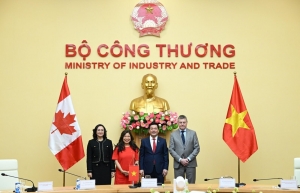CPTPP milestone marks nation’s economic integration
In January 2019, the Comprehensive and Progressive Agreement for Trans-Pacific Partnership (CPTPP) officially took effect with Vietnam. Along with the free trade agreement between Vietnam and the European Union taking effect in August 2020, the CPTPP promised to bring many opportunities for Vietnam.
 |
| Prof. Dr. Andreas Stoffers |
A total of 12 countries are now CPTPP members. The United Kingdom and the current members signed an accession protocol in July 2023 after two years of negotiations. The United Kingdom will join the agreement as soon as it has been ratified by all parties, or after 15 months if the UK and the majority of parties have ratified it. The trade bloc will then account for around 15 per cent of global GDP. It is legitimate to say that the CPTPP is one of the largest and most dynamic free trade areas in the world.
Over the past half-decade, Vietnam’s journey within the agreement’s framework has been marked by significant achievements and notable challenges, underscoring the dynamic nature of its integration into the global economy.
In recent times, Vietnam has faced a number of economic challenges. These primarily include exogenous factors: the immense national debt, particularly in the Eurozone and the United States, the slow recovery in the Eurozone, the war in Ukraine, the Middle East conflict, and now disruption to shipping routes in the Red Sea are also having an impact on Vietnam’s economy, as the country is deeply integrated into international supply chains.
However, the figures in most areas of Vietnam’s economy are encouraging. These include the ongoing expansion of the industrial sector, not least due to the production of high-tech goods, strong export-import growth in the first two months of the new year, and foreign direct investment. The growth path is intact, and experts estimate growth of 6-6.5 per cent for 2024, well above the global trend of 2.4-31 per cent. At the same time, inflation remains a thread, but is still manageable.
The basic prerequisite for this positive development of the Vietnamese economy was the open market economy policy that Vietnam has pursued since the economic reforms in the 1980s. This includes a commitment to a market economy, low public debt, a cautious monetary policy by the State Bank of Vietnam, especially for the past decade, and the attempt to find a balanced relationship with all world powers.
Vietnam’s openness to free trade with 17 free trade agreements has certainly contributed significantly to the positive development, but due to the outstanding importance of the Asia-Pacific region in the 21st century, the CPTPP is of particular significance.
Of course, there are still many things to be carried out, but the signs point to sustainable growth in Vietnam’s trade relations. Incidentally, this is also the view of the current Economic Freedom Report 2024 from World Heritage. Here, compared to all other countries, Vietnam is the fastest improving country since the report was first published 30 years ago. In the last year alone, it has climbed 12 places. The report emphasises the major role played by Vietnam’s open trade policy in achieving these impressive figures.
It is free trade agreements like the CPTPP that will help Vietnam on its way to becoming an industrialised country by 2045. These agreements have not only facilitated smoother trade flows but have also attracted substantial foreign investment into the country, contributing to its economic growth and resilience. Trade and foreign investment go hand in hand and are mutually dependent.
What needs to be done?
In order to further strengthen Vietnam’s foreign trade, it is important to diversify or strengthen trading partners in view of geostrategic challenges. The past has shown that excessive dependence on just one import or export partner can lead to difficulties if this partner collapses for whatever reason.
During the recent pandemic, trade with China suffered greatly. At that time, it was critical that Vietnam also had other trading partners up its sleeve. The CPTPP plays an essential role in this diversification because it covers key markets in Asia Pacific. From the Vietnamese perspective, a very positive point of the CPTPP is the deeper market access expansion to the American markets, which is a crucial contribution for its economic growth.
Notably, Vietnam has established strong trade ties with new partners such as Canada, Mexico, and Peru. In particular, Vietnam’s seafood exports have flourished. From $2.2 billion in 2018, they peaked at $2.9 billion in 2022 and reached $2.4 billion in 2023.
Among the member countries, Vietnam’s seafood market has experienced the second-strongest growth rate, trailing only China. Now the UK is entering into the CPTPP, the deal is even more attractive for Vietnam.
At the same time, there are more options for investments and technology transfer via an intensified partnership with the CPTPP countries: In fact, foreign direct investment (FDI) from member countries has consistently increased each year. In 2019, Vietnam attracted approximately $9.5 billion in FDI from CPTPP nations. By 2022, this figure rose to around $11.5 billion – an impressive $2.6 billion increase compared to 2021.
Key contributors were Singapore and Japan, both members, who have played a pivotal role. In the first nine months of 2023, they contributed a remarkable two-thirds of the total registered FDI capital.
Healthy pressure for reforms
Certainly, the CPTPP is also a driving force for institutional reforms because Vietnam has swiftly amended and promulgated a comprehensive set of legal documents to effectively implement its regulations. Some of these documents were issued retroactively to ensure businesses’ interests during the commitment implementation. Of course, this pressure for reform is not solely due to the deal.
There are several points in particular that Vietnam can still work on to improve cooperation with CPTPP partners. Firstly, it presents both competitive opportunities and challenges for domestic businesses. Vietnamese enterprises must consistently enhance their competitiveness to thrive in the global market while preventing erosion of their domestic market share. To achieve this, they should diligently meet stringent export quality standards aligned with international norms and invest in high-quality human resources for modern, technology-driven industries.
Secondly, brand protection abroad entails considering elements such as raw material sourcing, production origins, and packaging labels. Strong branding enhances trust and recognition in international markets.
Vietnam must also upgrade the logistics system, as heavy reliance on foreign fleets poses challenges. To enhance export capabilities, Vietnam should invest in developing its own shipping fleet equipped with refrigeration systems that meet export standards. Streamlining logistics processes, improving storage facilities, and ensuring timely delivery are also crucial for maintaining product quality during transit.
Meanwhile, the Vietnamese government should actively facilitate research, promulgate relevant legal documents, and guide businesses in implementing the deal’s commitments. This includes reducing risk, increasing transparency, and streamlining administrative procedures.
In terms of import and export regulations, ensuring compliance in areas like taxes and rules of origin is vital. Additionally, proactive trade defence measures aligned with international norms are essential for safeguarding Vietnam’s economic interests. The CPTPP also entails reducing tariffs and preventing tax shifting, and Vietnam needs to ensure that tax reduction does not affect budget revenue.
Vietnam should also enhance collaboration with other members to leverage trade and investment opportunities, promoting economic and trade development in the promising Asia-Pacific region.
As Vietnam commemorates its five-year journey within the framework, it stands at a pivotal juncture, poised for further integration and prosperity. By addressing prevailing challenges head-on and capitalising on emerging opportunities, Vietnam can chart a course towards sustained economic growth and prosperity for its people and the region at large.
Through strategic reforms, proactive engagement, and a steadfast commitment to excellence, Vietnam can navigate the complexities of the global economy with confidence and resilience, solidifying its position as a dynamic hub of trade and investment in the Asia-Pacific region.
 | UK-Vietnam trade pact already demonstrating value The United Kingdom-Vietnam trade relationship is poised to reach new heights, buoyed by the celebration of 50 years of UK-Vietnam bilateral relations last year, guided by the continued implementation of the UK-Vietnam Free Trade Agreement (UKVFTA), and further boosted by the UK joining the Comprehensive and Progressive Trans-Pacific Partnership (CPTPP). |
 | Canada favours Vietnam market A delegation of nearly 200 Canadian businesses is visiting Vietnam from March 26 to 29 to boost trade and investment. |
What the stars mean:
★ Poor ★ ★ Promising ★★★ Good ★★★★ Very good ★★★★★ Exceptional
Related Contents
Latest News
More News
- Opportunities reshaped by disciplined capital aspects (December 08, 2025 | 10:05)
- Fresh M&A cycle ahead as reforms begin to take effect (December 08, 2025 | 08:00)
- What foreign investors need to know to unlock new deals (December 08, 2025 | 08:00)
- Telecoms advances expected to penetrate all sectors and fields (December 03, 2025 | 13:00)
- Main drivers for Vietnam’s digital economy future (December 03, 2025 | 11:35)
- Pivotal stage of growth paves way for rise in M&As (December 03, 2025 | 10:00)
- Positive projections for M&A interest from Thailand (December 03, 2025 | 09:40)
- Manifesting the first line of defence in cybersecurity (December 03, 2025 | 09:00)
- The transformational role AI can play in accounting arena (December 03, 2025 | 08:00)
- Unlocking 5G-AI potential in Singapore (December 03, 2025 | 08:00)

 Tag:
Tag:



















 Mobile Version
Mobile Version